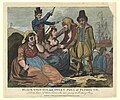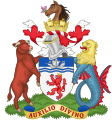Portal:Devon
The Devon Portal

Devon (/ˈdɛvən/ DEV-ən; historically also known as Devonshire /-ʃɪər, -ʃər/ -sheer, -shər) is a ceremonial county in South West England. It is bordered by the Bristol Channel to the north, Somerset and Dorset to the east, the English Channel to the south, and Cornwall to the west. The city of Plymouth is the largest settlement, and the city of Exeter is the county town.
Devon has a varied geography. It contains Dartmoor and part of Exmoor, two upland moors which are the source of most of the county's rivers, including the Taw, Dart, and Exe. The longest river in the county is the Tamar, which forms most of the border with Cornwall and rises in the Devon's northwest hills. The southeast coast is part of the Jurassic Coast World Heritage Site, and characterised by tall cliffs which reveal the Triassic, Jurassic and Cretaceous geology of the region. The county gives its name to the Devonian geologic period, which includes the slates and sandstones of the north coast. Dartmoor and Exmoor have been designated national parks, and the county also contains, in whole or in part, five national landscapes.
In the Iron Age, Roman and the Sub-Roman periods, the county was the home of the Dumnonii Celtic Britons. The Anglo-Saxon settlement of Britain resulted in the partial assimilation of Dumnonia into the kingdom of Wessex in the eighth and ninth centuries, and the western boundary with Cornwall was set at the Tamar by king Æthelstan in 936. (Full article...)
Selected article -

Plymouth Argyle Football Club is an English association football club based in Plymouth, Devon. Founded in 1886 as Argyle Football Club, they became a professional club in January 1903, and were elected to the Southern League ahead of the 1903–04 season. The club won the Southern League championship in 1913 and finished as runners-up on two occasions, before being elected to the Football League in 1920, where they compete to this day, as a founder member of the Third Division. Argyle won their first Football League championship, and promotion to the Second Division for the first time, ten years later in 1930. As of 2010, the club has won five championships in the Football League, gained promotion on eight occasions, and been relegated eight times. Four of those league championships were won in the third tier, which is a divisional record. Argyle have made one appearance at Wembley Stadium, in which they won the 1996 Third Division play-off final. The club has also achieved moderate success in domestic cup competitions; they reached the semi-finals of the FA Cup in 1984, and the quarter-finals in 2007. Argyle have also reached the semi-finals of the League Cup twice, in 1965 and 1974.
The Plymouth Argyle Player of the Year award is voted for annually by the club's supporters. It recognises the best overall performance by an individual player through the course of the season. Each year, the winner is presented with the trophy on the pitch at Home Park before the club's last home game of the season. This is the more prestigious of the two awards made by Plymouth Argyle itself, with the other being the Young Player of the Year accolade. Since its inception in 1966, thirty-nine different players have won the award. Six of these players have lifted the award for a second time, the most recent being Welsh international Carl Fletcher. As of the 2010–11 season, only striker Tommy Tynan has received the award for a third time. Three players have lifted the trophy in consecutive seasons; the first was Paul Mariner in 1976. Steve McCall matched that feat in the 1994, and Carl Fletcher became the third in 2011. Seven winners of the award have represented their country at international level. Six winners have gone on to become the club's manager. The 2012–13 winner was Onismor Bhasera, who made 46 appearances in all competitions during the campaign. Top goalscorer Reuben Reid won the award the following season, becoming the first forward to win the award since Mickey Evans. (Full article...)General images
Selected image

Recently featured: Bigbury sea tractor - Crazywell cross - South Devon Cattle - Dartmoor tors – Plymouth harbour – Westward Ho! beach
Subcategories
Map
Related portals
Did you know...

- ... that Plymouth's lighthouse, Smeaton's Tower (pictured), was dismantled and then rebuilt on Plymouth Hoe as a memorial?
- ... that Devon is the third largest of the English counties and has a population of 1,109,900?
- ... that the name Devon derives from the name of the Celtic people who inhabited the southwestern peninsula of Britain at the time of the Roman invasion?
- ... that Devon was one of the first areas of England settled following the end of the last ice age?
- ... that the St Nicholas Priory in Exeter is being restored with the same methods that were used 500 years ago?
- ... that Devon is the only county in England to have two separate coastlines?
- ... that there was no established coat of arms for Devon until 1926?
- ... that the English Riviera Geopark in Torbay is the world's only urban Geopark?
Topics
WikiProjects
Associated Wikimedia
The following Wikimedia Foundation sister projects provide more on this subject:
-
Commons
Free media repository -
Wikibooks
Free textbooks and manuals -
Wikidata
Free knowledge base -
Wikinews
Free-content news -
Wikiquote
Collection of quotations -
Wikisource
Free-content library -
Wikiversity
Free learning tools -
Wikivoyage
Free travel guide -
Wiktionary
Dictionary and thesaurus















































































































